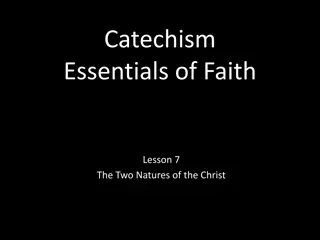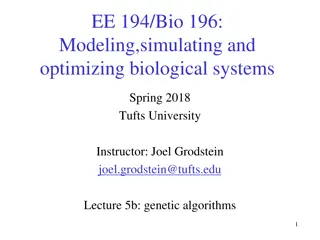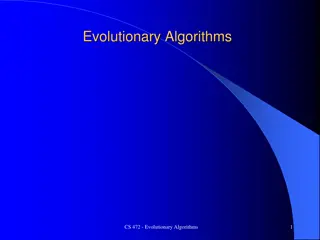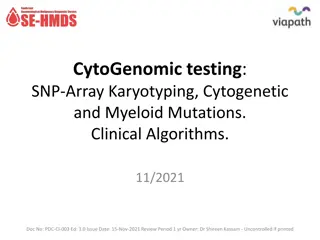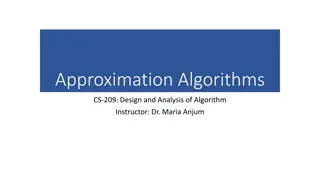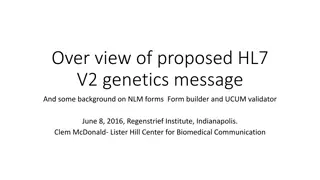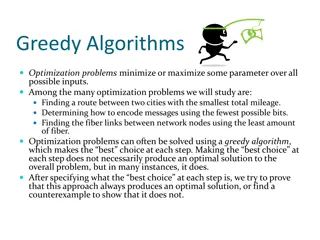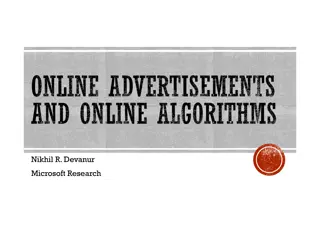Understanding Genetic Algorithms: Nature's Optimization Technique
Genetic algorithms (GAs) are a powerful search technique inspired by evolutionary biology. Starting with a population of randomly generated individuals, GAs evolve solutions through generations by evaluating fitness, selecting, and modifying individuals. The process continues until a satisfactory outcome is achieved. GAs have a rich history dating back to the early 1960s and have been extensively applied across various fields. This summary covers the fundamental concepts, evolution process, and vocabulary associated with genetic algorithms.
Download Presentation

Please find below an Image/Link to download the presentation.
The content on the website is provided AS IS for your information and personal use only. It may not be sold, licensed, or shared on other websites without obtaining consent from the author. Download presentation by click this link. If you encounter any issues during the download, it is possible that the publisher has removed the file from their server.
E N D
Presentation Transcript
Algorithms in Nature Genetic algorithms
History of GAs As early as 1962, John Holland's work on adaptive systems laid the foundation for later developments. By the 1975, the publication of the book Adaptation in Natural and ArtificialSystems, by Holland and his students and colleagues.
History of GAs early to mid-1980s, genetic algorithms were being applied to a broad range of subjects. In 1992 John Koza has used genetic algorithm to evolve programs to perform certain tasks. He called his method "genetic programming" (GP).
What is GA A genetic algorithm (or GA) is a search technique used in computing to find true or approximate solutions to optimization and search problems. (GA)s are categorized as global search heuristics. (GA)s are a particular class of evolutionary algorithms that use techniques inspired by evolutionary biology such as inheritance, mutation, selection, and crossover (also called recombination).
What is GA The evolution usually starts from a population of randomly generated individuals and happens in generations. In each generation, the fitness of every individual in the population is evaluated, multiple individuals are selected from the current population (based on their fitness), and modified to form a new population.
What is GA The new population is used in the next iteration of the algorithm. The algorithm terminates when either a maximum number of generations has been produced, or a satisfactory fitness level has been reached for the population. No convergence rule or guarantee!
Vocabulary Individual -Any possiblesolution Population - Group of all individuals Fitness Target function that we are optimizing (each individual has a fitness) Trait - Possible aspect (features) of an individual Genome - Collection of all chromosomes (traits) foran individual.
Basic GeneticAlgorithm Start with a large population of randomly generated attempted solutions to a problem Repeatedly do the following: Evaluate each of the attempted solutions (probabilistically) keep a subset of the best solutions Use these solutions to generate a new population Quit when you have a satisfactory solution (or you run out of time)
Example: the MAXONEproblem Suppose we want to maximize the number of ones in a string of l binary digits Is it a trivial problem? It may seem so because we know the answer in advance However, we can think of it as maximizing the number of correct answers, each encoded by 1, to l yes/no difficult questions` 10
Example (cont) An individual is encoded (naturally) as a string of l binary digits The fitness f of a candidate solution to the MAXONE problem is the number of ones in its genetic code We start with a population of n random strings. Suppose that l = 10 and n = 6 11
Example (initialization) We toss a fair coin 60 times and get the following initial population: s1 =1111010101 s2 =0111000101 f (s1) = 7 f (s2) = 5 s3 =1110110101 s4 =0100010011 f (s4) = 4 f (s3) = 7 s5 =1110111101 s6 =0100110000 f (s6) = 3 f (s5) = 8 12
Step 1: Selection We randomly (using a biased coin) select a subset of the individuals based on their fitness: Individual i will have a f (i) f(i) i probability to be chosen Area is Proportional to fitness value 1 2 n 3 4 13
Selectedset Suppose that, after performing selection, we get the following population: s1` = 1111010101 (s1) s2` = 1110110101 (s3) s3` = 1110111101 (s5) s4` = 0111000101 (s2) s5` = 0100010011 (s4) s6` = 1110111101 (s5) 14
Step 2: crossover Next we mate strings for crossover. For each couple we first decide (using some pre-defined probability, for instance 0.6) whether to actually perform the crossover or not If we decide to actually perform crossover, we randomly extract the crossover points, for instance 2 and 5 15
Crossoverresult Before crossover: s1` = 1111010101 s2` = 1110110101 After crossover: s1`` = 1110110101 s2`` = 1111010101 16
Step 3: mutations The final step is to apply random mutations: for each bit that we are to copy to the new population we allow a small probability of error (for instance 0.1) Initial strings s1`` = 1110110101 After mutating s1``` = 1110100101 s2`` = 1111010101 s2``` = 1111110100 s3`` = 1110111101 s3``` = 1110101111 s4`` = 0111000101 s4``` = 0111000101 s5`` = 0100011101 s5``` = 0100011101 s6``` = 1110110001 s6`` = 1110110011 17
And now, iterate In one generation, the total population fitness changed from 34 to 37, thus improved by ~9% At this point, we go through the same process all over again, until a stopping criterion is met
Biological Background The cell Every animal cell is a complex of many small factories working together. The nucleus in the center of the cell. The nucleus contains the geneticinformation
Biological Background Chromosomes Genetic information is stored in the chromosomes Each chromosome is built of DNA Genes are encoded in the chromosomes Genes code for proteins Every gene has a unique position on the chromosome
Biological Background: Genotype and phenotype The entire combination of genes is called genotype A genotype leads to a phenotype (eye color,height, disease predisposition) The phenotype is affected by changes to the underlying genetic code
Biological Background Reproduction Reproduction of geneticalinformation Mitosis Meiosis Mitosis is copying the same genetic information to new offspring: there is no exchange of information Mitosis is the normal way of growing of multicell structures, like organs.
Biological Background Reproduction Meiosis is the basis of sexual reproduction After meiotic division 2 gametes appear In reproduction two gametes conjugate to a zygote which will become the new individual Crossovers leads to new genotype
Mutations In any copying process errors can occur, sosingle (point) mutations ate pretty common. Other types of errors, including affecting longer regoins (either deletion, inversions, substitutionsetc.) can also occur
Natural selection The origin of species: Preservation of favourable variations and rejection of unfavourablevariations. There are more individuals born than can survive, so there is a continuous struggle for life. Individuals with an advantage have a greater chance for survive: so survival of the fittest.
GAOperators Methods of representation Methods of selection Methods of Reproduction
Common representation methods Binary strings. Arrays of integers (usuallybound) Arrays of letters .
Methods of Selection There are many different strategies to select the individuals to be copied over into the next generation
Methods of Selection Roulette-wheel selection. Elitist selection. Fitness-proportionate selection. Scaling selection. Rank selection.
Roulette wheel selection Conceptually, this can be represented as a game of roulette - each individual gets a slice of the wheel, but more fit ones get larger slices than less fit ones.
Roulette wheel selection No. String Fitness % Of Total 1 01101 169 14.4 2 11000 576 49.2 3 01000 64 5.5 4 10011 361 30.9 Total 1170 100.0
Other selection methods Elitist selection: Chose only the most fit members of each generation. Cutoff selection: Select only those that are above a certain cutoff for the target function.
Methods of Reproduction There are primary methods: Crossover Mutation
Methods of Reproduction: Crossover Two parents produce two offspring Two options: 1.The chromosomes of the two parents are copied to the next generation 2.The two parents are randomly recombined (crossed-over) to form new offsprings
Several possible crossover strategies Randomly select a single point for a crossover Multi point crossover Uniform crossover
Two-point crossover Avoids cases where genes at the beginning and end of a chromosome are always split Parents: 1010001110 0011010010 Offspring: 0101010010 0011001110
Crossover Single point crossover Cross point Two point crossover (Multi point crossover)
Uniform crossover A random subset ischosen The subset is taken from parent 1 and the other bits from parent2. Subset: BAABBAABBB (Randomly generated) Parents: 1010001110 0011010010 Offspring: 0011001010 1010010110
Methods of Reproduction: Mutations Generating new offspring from single parent
A (slightly moreinvolved) example The Traveling Salesman Problem: Find a tour of a given set of cities so that each city is visited only once the total distance traveled is minimized
Representation Representation is an ordered list of city numbers known as an order-basedGA. 1) London 2) Venice 3) Dunedin 4) Singapore 5) Beijing 6) Phoenix 7) Tokyo 8) Victoria (3 5 7 2 1 6 4 8) (2 5 7 6 8 1 3 4) CityList1 CityList2
Crossover Crossover combines inversion and recombination: * (3 5 7 2 1 6 4 8) (2 5 7 6 8 1 3 4) * Parent1 Parent2 (5 8 7 2 1 6 3 4) Child This operator is called the Order1 crossover.
Mutation Mutation involves reordering of the list: * * Before: (5 8 7 2 1 6 3 4) After: (5 8 6 2 1 7 3 4)
TSP Example: 30 Cities 120 100 80 y 60 40 20 0 0 10 20 30 40 60 70 80 90 100 50 x
Solution i (Distance =941) TSP30 (Performance = 941) 120 100 80 y 60 40 20 0 0 10 20 30 40 50 60 70 80 90 100 x
Solution j(Distance = 800) TSP30 (Performance = 800) 120 100 80 y 60 40 20 0 50 0 10 20 30 40 60 70 80 90 100 x
Solution k(Distance = 652) TSP30 (Performance = 652) 120 100 80 y 60 40 20 0 0 10 20 30 40 60 70 80 90 100 50 x
Best Solution (Distance = 420) TSP30 Solution (Performance = 420) 120 100 80 y 60 40 20 0 50 0 10 20 30 40 60 70 80 90 100 x
GAApplications Domain ApplicationType Control Gas pipeline, missile evasion Design Aircraft design, keyboard configuration, communication networks Game playing Poker,checkers Security Encryption and Decryption Robotics Trajectory planning




